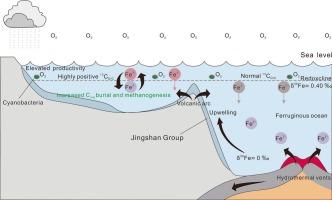Timing and origin of the Lomagundi-Jatuli Event: Insights from UPb geochronology, C-O-Fe isotopes and REE compositions from the Jingshan Group, North China Craton
IF 2.6
2区 地球科学
Q2 GEOGRAPHY, PHYSICAL
Palaeogeography, Palaeoclimatology, Palaeoecology
Pub Date : 2024-10-24
DOI:10.1016/j.palaeo.2024.112574
引用次数: 0
Abstract
The Lomagundi-Jatuli Event (LJE) represents perhaps the largest and longest positive carbon isotope excursion of Earth history. However, the synchroneity, scale, and linkage of the LJE to Earth's early history of atmospheric oxygenation remain controversial. Strata of the Paleoproterozoic Jingshan Group of the North China Craton that preserve the isotopic record of the LJE excursion in marble layers and abundant graphite deposits provide an opportunity to elucidate the significance of the LJE. Carbon isotopic values (δ13CV-PDB) of the LJE based on analysis of 20 samples of the Lugezhuang Formation, lower Jingshan Group, range from −0.8 to +9.6 ‰ and display positive co-variance with stable oxygen isotope values (δ18OV-PDB). The positive carbon isotope excursion is constrained to 2140.6 ± 8.5 Ma (MSWD = 0.82, n = 25) based on magmatic zircon U![]() Pb geochronology of biotite granulite. Variation of facies-dependent carbon isotope values, the presence of graphite deposits of the Douya Formation, upper Jingshan Group, and the absence of a Ce anomaly in PAAS normalized REE patterns of marble samples suggest that the positive carbon isotope excursion is not linked to a marked increase of organic carbon burial and associated significant atmosphere oxygenation. Elevated concentrations of iron and PAAS-normalized middle REE enrichment of analyzed Jingshan Group marble samples point to anoxic and ferruginous oceanic conditions during accumulation of Jingshan Group carbonate. A positive Eu anomaly (average = 1.58), low La (average = 0.23), (Nd/Yb)N (average = 1.27), and Y/Ho (average = 36.6) anomalies, and negative iron isotope values (average δ56Fe = −0.12 ‰) are consistent with accumulation of Paleoproterozoic Jingshan Group carbonate in a restricted marine setting that was affected by high temperature hydrothermal fluids. Enrichment of the studied samples in heavy carbon isotope suggests elevated bio-productivity in the restricted, redox stratified marine setting in which Jingshan Group carbonate accumulated. Thus, it is likely that the positive stable carbon isotope excursion associated with Jingshan Group strata as well as other contemporaneous isotope excursions are local signals that are linked to a global perturbation of the carbon cycle.
Pb geochronology of biotite granulite. Variation of facies-dependent carbon isotope values, the presence of graphite deposits of the Douya Formation, upper Jingshan Group, and the absence of a Ce anomaly in PAAS normalized REE patterns of marble samples suggest that the positive carbon isotope excursion is not linked to a marked increase of organic carbon burial and associated significant atmosphere oxygenation. Elevated concentrations of iron and PAAS-normalized middle REE enrichment of analyzed Jingshan Group marble samples point to anoxic and ferruginous oceanic conditions during accumulation of Jingshan Group carbonate. A positive Eu anomaly (average = 1.58), low La (average = 0.23), (Nd/Yb)N (average = 1.27), and Y/Ho (average = 36.6) anomalies, and negative iron isotope values (average δ56Fe = −0.12 ‰) are consistent with accumulation of Paleoproterozoic Jingshan Group carbonate in a restricted marine setting that was affected by high temperature hydrothermal fluids. Enrichment of the studied samples in heavy carbon isotope suggests elevated bio-productivity in the restricted, redox stratified marine setting in which Jingshan Group carbonate accumulated. Thus, it is likely that the positive stable carbon isotope excursion associated with Jingshan Group strata as well as other contemporaneous isotope excursions are local signals that are linked to a global perturbation of the carbon cycle.

洛马昆迪-贾图里事件的时间和起源:来自华北克拉通京山群的UPb地质年代、C-O-Fe同位素和REE成分的启示
Lomagundi-Jatuli 事件(LJE)可能是地球历史上规模最大、时间最长的碳同位素正偏移。然而,LJE 的同步性、规模以及与地球早期大气含氧历史的联系仍存在争议。华北克拉通古生代景山群地层中的大理岩层和丰富的石墨沉积中保存了 LJE 偏移的同位素记录,为阐明 LJE 的意义提供了机会。根据对京山下统鲁各庄组20个样品的分析,LJE的碳同位素值(δ13CV-PDB)在-0.8至+9.6‰之间,并与稳定氧同位素值(δ18OV-PDB)呈正共变关系。根据生物花岗岩的岩浆锆石UPb地质年代学,碳同位素的正偏移被限制在2140.6 ± 8.5 Ma (MSWD = 0.82, n = 25)。与岩相相关的碳同位素值的变化、京山组上统豆芽地层石墨沉积的存在以及大理岩样品的PAAS归一化REE模式中没有Ce异常,都表明碳同位素的正偏移与有机碳埋藏的明显增加以及相关的大气含氧量的显著增加无关。所分析的京山群大理岩样品中铁浓度的升高和PAAS归一化中REE的富集表明,在京山群碳酸盐岩堆积过程中存在缺氧和铁质海洋条件。正的Eu异常(平均=1.58),低的La(平均=0.23)、(Nd/Yb)N(平均=1.27)和Y/Ho(平均=36.6)异常,以及负的铁同位素值(平均δ56Fe=-0.12‰),都与古近纪京山群碳酸盐岩在受高温热液影响的限制性海洋环境中堆积一致。所研究样本重碳同位素的富集表明,京山群碳酸盐岩在受限的氧化还原分层海洋环境中的生物生产率较高。因此,与景山群地层相关的正稳定碳同位素偏移以及其他同期同位素偏移很可能是与全球碳循环扰动相关的局部信号。
本文章由计算机程序翻译,如有差异,请以英文原文为准。
求助全文
约1分钟内获得全文
求助全文
来源期刊
CiteScore
5.90
自引率
10.00%
发文量
398
审稿时长
3.8 months
期刊介绍:
Palaeogeography, Palaeoclimatology, Palaeoecology is an international medium for the publication of high quality and multidisciplinary, original studies and comprehensive reviews in the field of palaeo-environmental geology. The journal aims at bringing together data with global implications from research in the many different disciplines involved in palaeo-environmental investigations.
By cutting across the boundaries of established sciences, it provides an interdisciplinary forum where issues of general interest can be discussed.

 求助内容:
求助内容: 应助结果提醒方式:
应助结果提醒方式:


